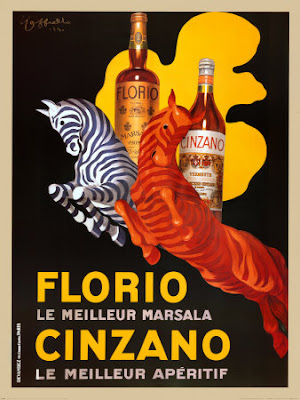Vermouth is most widely known in America as 'the other' ingredient in Martinis and Manhattans and is often treated with extreme caution. Maybe unsurprisingly the view of it in Europe is quite the opposite, where it is a much more appreciated liquor and often served as an aperitif. In America vermouth still remains almost an enigma, known as a strong flavored alcohol that mixes well into the cocktails where it is called for but not receiving much attention into most bars signature drinks.
The exact origins of vermouth are somewhat convoluted, most of this confusion seems to come from its name. At its base vermouth is simply wine that has been fortified, normally with brandy, and then flavored with various herbs. Antonio Benedetto Carpano of Turin Italy is acknowledged to have been the person to coin the term vermouth for the aromatized wine he had been producing. It is said that he took the name vermouth form the German word Wermut meaning Wormwood. Supposedly he took this name because of the popularity of German fortified wine that was often flavored with Wormwood. although Carpono is credited with the coining of the term Vermouth, the actual history 0f fortified wines infused with Mediterranean herbs stretches back centuries. As with many liquors, especially those infused with herbs, the original intent was that of a tonic. The herbs that are contained in vermouth were not only added for flavor but often for the healing properties they were supposed to possess. It is notable that wormwood had been used as a treatment for intestinal worms as far back as ancient Greece. The production of herbed, fortified wine was common for many European households through the 17th century. It was not until the early 1800's that large scale production of specific styles of infused wines, such as vermouth, became popular.
By the mid 1800's three main companies were competing and producing vermouth in Italy: Carpano, Martini & Rossi and Cinzano. Martini & Rossi was formed by Alessandro Martini and Luigi Rossi in 1863. Both men had been employed in Turin by a distributor of wines and liquors and decided to try their hand at creating a vermouth that they hoped would be of the highest quality and consistency possible. Their endeavor paid off, with their vermouth almost immediately receiving a grand price at Dublin in 1865. The vermouth would eventually claim 13 grand prizes by 1912. Brothers Giovanni and Carlo Cinzano began producing aromatic wines in the mid 1700's including their signature vermouth. The company became notable in 1840 for creating the first Italian sparkling wine, after the brothers had been chartered to create a wine to compete with french Champagnes which had been quickly gaining popularity. Cinzano has often been recognized for its advertising campaigns, often using exotic images to capture customers attention . The company was on one of the first adopters of both mail drop advertisements during the 30's and 40's and television advertising which helped their sales in the 70's. The Carpano group acquired the Cinzano brand in 1999 and is now the second largest retailer of vermouth in the world.
During this same time french company Noilly Prat would begin to produce a dry style vermouth. Noilly Prat was founded by a French herbalist Joseph Noilly who created a signature vermouth recipe in 1813 created a company base on in 1855 with his son in law Claudius Prat. The french Clairette and Picpoul grapes they used to make this dry vermouth also gave it its signature golden color compared to the red tone of Italian vermouth.
Most of the vermouth brands base much of their quality on their secret recipe of herbs. Noilly Pratt often advertises their secret blend of 20 different ingredients. The most common herbs that are found in vermouth blends are chamomile, bitter orange peel, nutmeg, century, coriander, and cloves. The aging process is also very specific, Noilly Prat for example uses 100 year old Canadian oak barrels for the first 8 months, and the a transfer to smaller barrels which are kept outside, as opposed to cellaring, to simulate the conditions seen by the barrels if they had been shipped across the ocean. During this time some of the vermouth is lost to evaporation, this amount has been referred to as the 'angles share'. In 1971 Martini & Rossi would purchase Noilly Prat making them the largest retailer of both french and Italian vermouth.
Cocktail Time
The Waldorf
The Waldorf Cocktail was one of the signature drinks of the
Waldorf-Astoria Bar at the beginning of the 20th Century
Waldorf-Astoria Bar at the beginning of the 20th Century
- 1 ounce bourbon
- 1 ounce sweet vermouth
- 1 ounce absinthe
Instructions: Combine ingredients in a mixing glass and fill with ice.
Stir well and strain into a chilled cocktail glass.
Gratuitous images for people who fear words




No comments:
Post a Comment